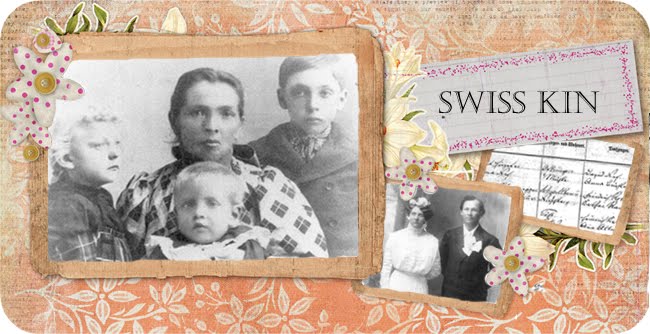Thursday, February 25, 2010
Research Guidance
Don't you wish you could have 24/7 access to a professional genealogist? Wouldn't it be nice to get professional help when you're starting to research in an area you have never been before? Well, you can! The professional genius of the Salt Lake City Family History Library workers have put together research helps and put them online for FREE! It's called Research Guidance. If you go to www.familysearch.org, then click on "Research Helps," then click on "Research Guidance," you have instant access to step-by-step guides. Unfortunately, there is not one for Switzerland, but there are guides for soooooo many areas. Go check it out!
Friday, February 19, 2010
Valentinstag
With Valentine’s Day this past week, I wanted to find out what the people in Switzerland America
And I found out that there is a Swiss chocolate confectionery called Teuscher Chocolates of Switzerland. My ancestors were Teuschers! Seems pretty appropriate for my family of chocolate lovers. Look at this gorgeousness!
Anyway, the Swiss people have only recently started celebrating Valentine’s Day, so it is most unlikely our ancestors celebrated it. However, there is another celebration that happens this time of year that they do celebrate and have been since the Middle Ages.
It is Fasnacht and is mainly celebrated in the town of Basel West Virginia
Fasnachtsküchlein
1 ¼ c. white flour
½ c. whole wheat flour
1 t. salt
2 eggs
3 T cream
Coconut fat or deep-frying oil
Confectioner’s sugar
Mix flour and salt. Beat eggs. Add eggs and cream to flour. Knead until dough is soft and even. Rinse a bowl with hot water, cover the dough with the bowl and leave it alone for about 30 min. Roll out dough as thin as you can get it. Cut out large circles. Form into rosettes and fry both sides until yellow. Sprinkle with confectioner’s sugar.
They sure looked pretty!

My response? Good, but as I’ve been hopelessly Americanized when it comes to sugar, they weren’t nearly sweet enough. Oh, well. My husband, children, and little neighbor boy loved them. I think I’ll go buy myself some Lindt truffles and call it good. Guten Fasnacht! J
Wednesday, February 10, 2010
What to do with what you have
Now that you know how to use a Research Log, it’s time to start researching. Where to go? What to do? I suggest you start with yourself. Get a box or a file folder and gather all the important documents that pertain to your life. Then use some sort of genealogical software to compile and store your information on the computer. I won’t discuss which software is best in this post because 1) All have pros and cons and 2) I haven’t decided myself, yet! I’m in the weeding process right now. I’ve used Personal Ancestral File for a long time, but it will no longer be updated, therefore I’ve got to choose another one. If you want to try some out before you buy, you can get some FREE trial versions. Here are a few.
1) Legacy Family Tree - http://www.legacyfamilytree.com/DownloadLegacy.asp
2) RootsMagic - http://www.rootsmagic.com/Try/RootsMagic/
3) FamilyInsight - http://www.ohanasoftware.com/?cl=buy&op=buy
4) Ancestral Quest - http://www.ancestralquestonline.com/updates/getlatest.asp?demo=1
Now your assignment is to gather your important documents, start looking into what software you like, and then entering information for yourself in some of the software. This will help you choose which you like best. Different versions will appeal differently to different people (did I type “different” enough?).
Wednesday, February 3, 2010
Now What Did I Just Do?
Do you ever have that question in your head when you're doing genealogical research? Do you find yourself questioning which books you've looked at or in what library you found that crucial document? Please don't do this to yourself any more! (Yes, I've done this myself many times; I have since learned better). That brings me to our topic for the week.
RESEARCH LOGS

One of the most important things about doing effective genealogical research is keeping a detailed research log. When I began genealogical research, I thought research logs were a PAIN. I did not want to take the time to keep a log as well as spend hours researching. A couple of research projects cured me of that mindset. Going back to do research over again because I can’t remember what I did in the first place is a much bigger pain. I love my research logs now! In fact, give me a thorough research log over a jelly doughnut any day! (Well, maybe not any day. I do love my desserts *wink*).
Okay, you get the idea. So what goes into a good research log? You’ve got to have:
1) the date of your research
2) the repository of your research. (If you’re new to genealogy, repository is just a fancy word for where the records are stored (your home, library, family history center, etc.)
3) the record searched (save yourself time and use the correct citation format now, see Evidence Explained by Mills). I’ll be talking about this MUCH more.
4) What pages you searched
5) The reason for the search
6) the findings, even the negative “I found NOTHING!” findings.
7) the document number-make a copy of any important finding and write a document number on it so it’s easy to find later.
8) the time spent on research if you are billing a client or researching for certification or accreditation.
8) the time spent on research if you are billing a client or researching for certification or accreditation.
Here is a sample of one of my own. Feel free to use it's design or make your own, personalizing it to your style.
So, my challenge for you today is to do a search in one record using your oh-so-handy Research Log. Have fun!
Subscribe to:
Comments (Atom)










